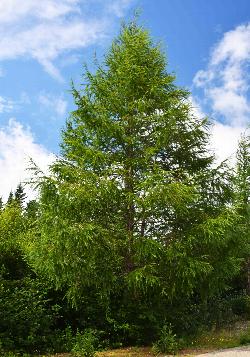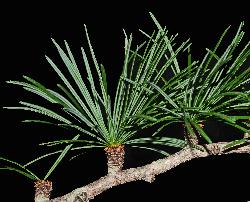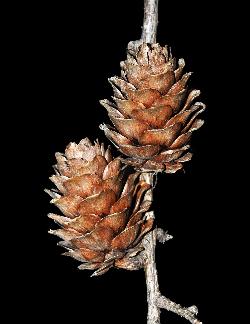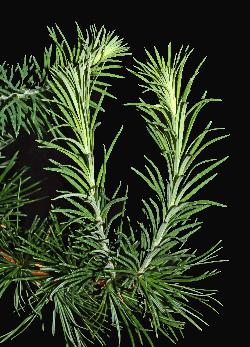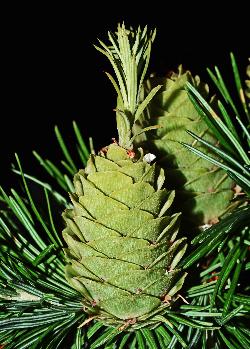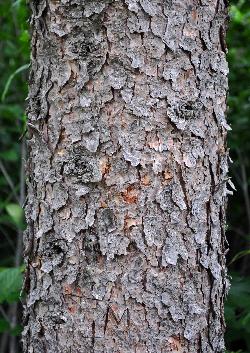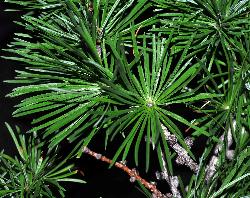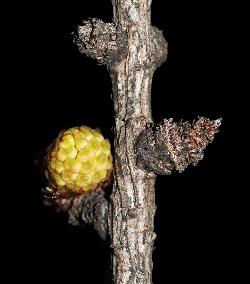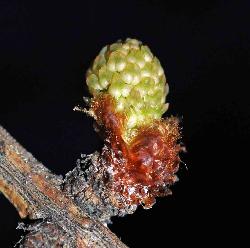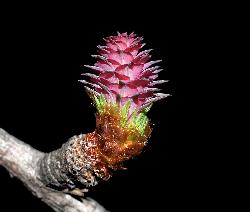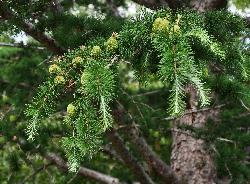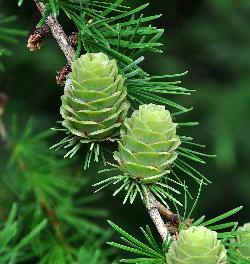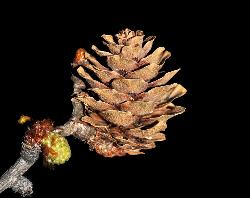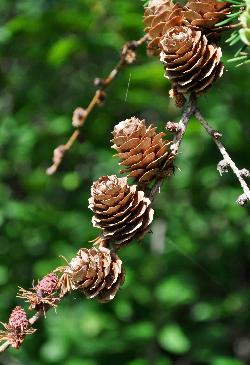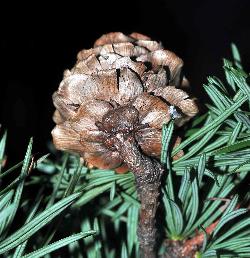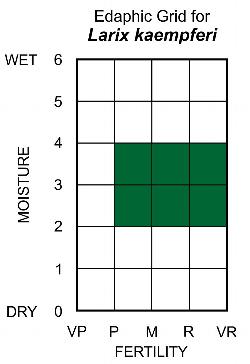Note: Numbers provided in square brackets in the text refer to the image presented above; image numbers are displayed to the lower left of each image.
General: A medium-sized, deciduous conifer, native to alpine regions of Japan. Japanese larch is 25 m tall, with a d.b.h. of up to 100 cm (Eckenwalder 2009). Japanese larch has a broad conical profile with horizontal to ascending branches [1]. Its needles are mainly borne in tufts on short shoots [2–3]. Japanese larch grows rapidly and is disease-resistant, attractive traits for a plantation tree (Eckenwalder 2009, Farrar 1995).
Key Features:
1. Spur shoots produce tufts of 40–50 needles [2–3], each 2–5 cm long; lower needle surfaces are glaucous [3].
2. Seed cones are ovoid, 2–5 cm long, with 30–40 broadly ovate cone scales; cones are light green when immature, and brown at maturity [4].
3. Cone scales are finely pubescent with margins that curve outward [5] at maturity, forming a rosette when viewed from above [6].
Stems/twigs: Young twigs are yellowish-brown to reddish-brown and glabrous; older twigs are greyish-brown to grey. Twigs have dark reddish-brown, slightly resinous, scaly buds, blunt to rounded at the apex, and about 3–5 mm long. Two types of shoots are produced on larch species: long shoots and spur shoots. The terminal long shoots, or leaders, are slender, with individual needles attached spirally along the shoot [7]; leaders produce both terminal and lateral buds, and are responsible for vertical and horizontal growth of the tree. Occasionally, long shoots are observed growing from the top of immature seed cones [8–9]. Spur shoots are short and stout, dark brown, and are slightly wider at the top of the shoot. Spur shoots are borne laterally on year-old and older stems and produce new tufts of needles each year; they produce terminal buds, but no lateral buds. Rows of minute leaf scars encircling the top of spur shoots [10]. The bark of mature trees is grey with flakey scales and reddish-brown inner bark [11].
Needles: Deciduous, simple, and sessile. Needles are slender, soft, glabrous, 2–5 cm long by 0.7–1 mm wide, green to bluish-green and flat above with a prominent midrib beneath [12–13]; up to 5 rows of stomates occur in a glaucous band along either side of the midrib on the lower needle surface (Eckenwalder 2009). The tips of the needles are pointed (acute) on long shoots, but blunt to rounded on spur shoots. On long shoots, needles are spirally arranged and attached directly to the stem by flat decurrent woody bases [14]. On spur shoots, needles are crowded in terminal tufts of 40–50 [15] (Farrar 1995). Japanese larch needles turn bright yellow in autumn before falling; the needles are not totally deciduous, with some persistent brown needles observed on spur shoots [16].
Reproductive structures/cones: Unisexual (trees monoecious), with separate male and female cones often appearing on the same branch [17] and emerging with the needles. Male cones are 5–6 mm in diameter and consist of a nearly spherical to oblong cluster of greenish-yellow to yellow anthers [18–21], terminating a spur shoot that lacks needles. Emerging female cones (conelets) are green to deep pink, ovoid, terminal on spur shoots, and are subtended by a few needles [22]. Immature seed cones [23–24] are light green, finely pubescent on the cone scale surface and margins [25–26] with short brown hairs. Mature seed cones [4, 27–28] are erect, reddish-brown to brown, broadly ovoid to spherical, 2–5 cm long, stalked, with a peduncle about 5 mm long [29], and have 30–40 cone scales (Farrar 1995, Eckwalder 2009). Open cones have somewhat undulate scales with broadly rounded margins that curve outward slightly, forming a rosette when viewed from above [6]. Cone scales exceed the subtending bracts, which are 5–7 mm long. Seeds are 3–4 mm long with a 7–11 mm long wing (Eckenwalder 2009). Cones develop in late spring and mature in fall; seeds are shed from the persistent cones at the end of the first growing season.
Ecology and Habitat: Japanese larch is native to Japan and was introduced to Newfoundland in research trials between 1967–1970 (Hall 1983) and, later, in operational plantations. It is endemic to Hoshu, the largest island of Japan, where it occurs on moist sites from 500 to 2900 m elevation. Unlike most larches, it does not do well on natural peat soils, although on a drained peatland afforestation trial in western Newfoundland, it outperformed all other species (Hall 1983). It is considered a light demanding species (shade-intolerant) that can withstand cold, but is adversely affected by wind. It requires 1000 mm of rainfall to grow well. Japanese larch is vulnerable to spring and autumn frosts (UK Forestry Commission 2016).
Edaphic Grid: See image [30]: the Edaphic Grid for Larix kaempferi.
Forest Types: Japanese larch only occurs in a limited number of plantations and experimental sites in Newfoundland and is not included in the forest vegetation classification. Based on the limited literature available, it would probably grow best in edaphic grid positions 3B–D, 4B–D.
Succession: Within its natural environment in Japan, Larix kaempferi forms an azonal Larix kaempferi Community on unstable habitats, such as volcanic lava and avalanche tracks. The forests are generally open with an understorey of black crowberry (Empetrum nigrum L.) and bog bilberry (Vaccinium uliginosum L.). In the absence of disturbance, this community is replaced by the climax association Abies vietchii-Abies mariesii. Larix kaempferi requires open habitats with lots of light to successfully germinate. It is, therefore, unlikely that it will encroach into natural mature stands of balsam fir or black spruce, although it could spread in disturbed habitats in Newfoundland.
Distribution: Japanese larch is endemic to Hoshu, Japan, but has been introduced throughout most of the boreal and temperate zones of the world in forest plantations and as a garden ornamental. Experimental plantations established in Newfoundland between 1967 and 1970 can be found at Cold Brook, Bottom Brook, Pelley’s Bog, North Pond, Avondale, and Windsor Lake.
Similar Species: Tamarack (Larix laricina (DuRoi) K.Koch), our only native larch, is easily distinguished from Japanese larch by tamarack's smaller glabrous cones (1–2 cm long). Like Japanese larch, European larch (Larix decidua Mill.), has also been used in plantation trials in Newfoundland. Japanese larch has wider cones with slightly reflexed cone scale margins, while European larch has cone scales margins that curve inward slightly; both introduced species have pubescent cone scales.


